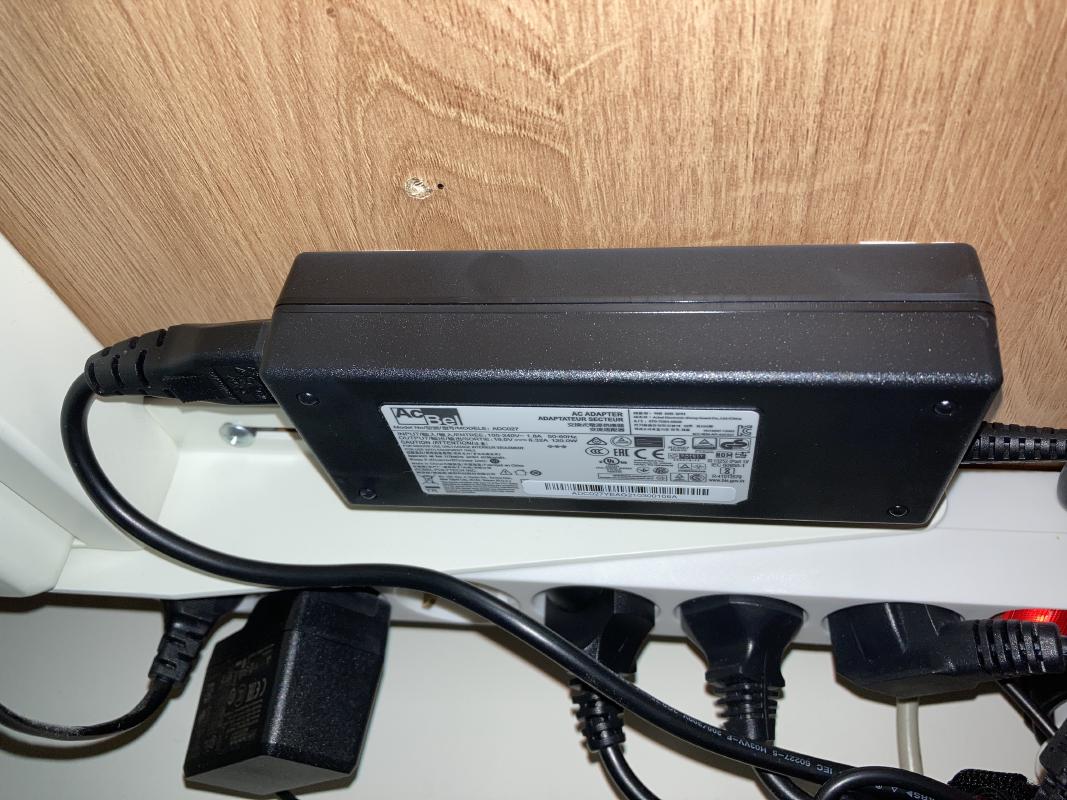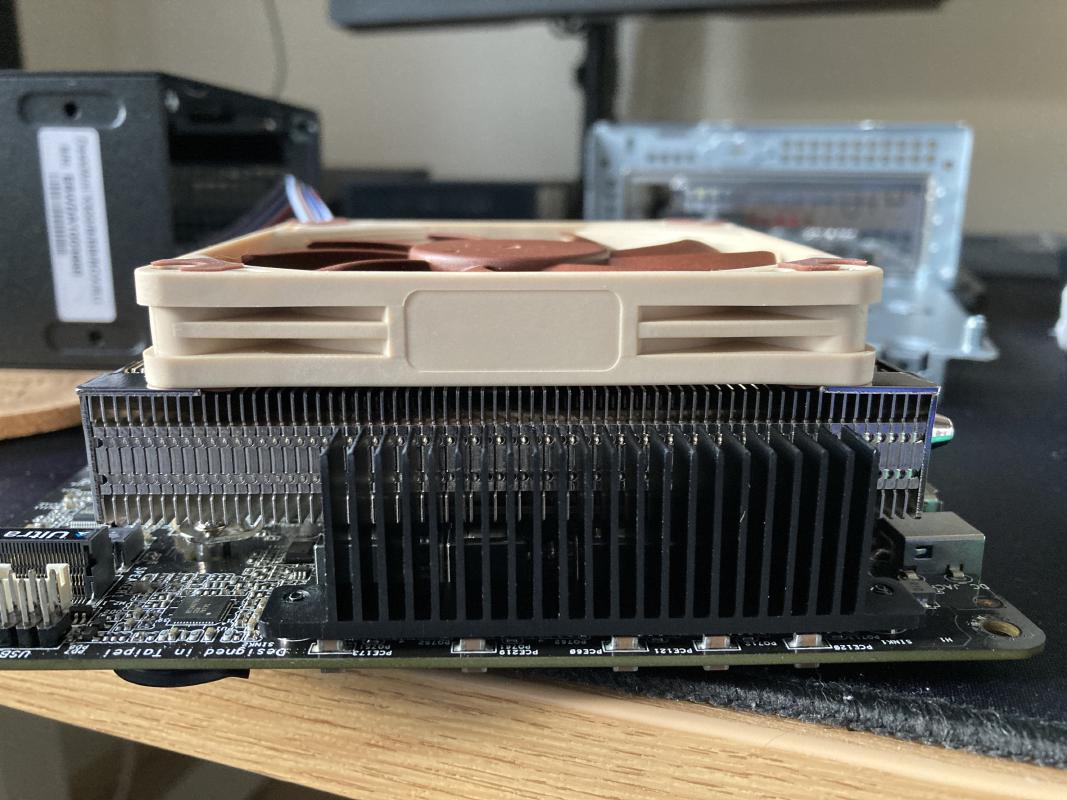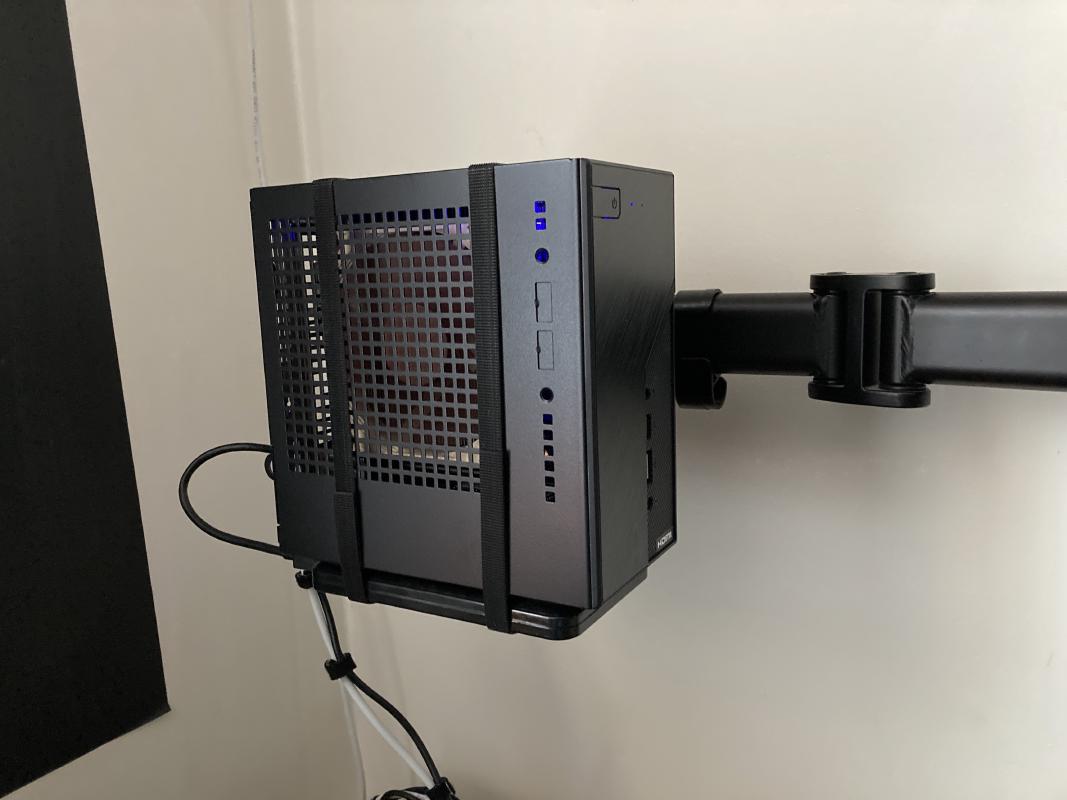ASRock DeskMini X300: the future form factor of desktop PC-s?
I wasn’t happy with my “one machine that does it all” setup, which is why I finally bit the bullet and got myself an ASRock DeskMini X300 bare-bones kit. This is a fantastic little desktop PC kit that is very small, quiet and can still be configured to have ridiculous amounts of power. In the past. I once built a low-power server based off of the predecessor, the DeskMini A300, and instantly fell in love with this form factor. Since then, I’ve tried to come up with a reason to get one, and finally I’ve got one.

Configuration
Because this is a bare-bones kit, you have to supply your own parts.
My configuration:
- CPU: AMD Ryzen 7 5700G, locked to 35 W TDP in UEFI settings.
- Cooling: Noctua NH-L9a
- RAM: 2x 16 GB DDR4-3200 SODIMM
- NVMe storage: 2x Samsung SSD 980 500GB
- SATA storage: 2x Samsung SSD 870 QVO 4TB
- USB storage: 1x Samsung SSD 860 EVO 250GB in an IcyBox USB enclosure

The use case for my kit is simple: it’s my server that hosts all my services and data, including this blog you’re reading.
Why this setup in particular?
- Most of my storage needs can be served by two 4 TB SSD-s.
- 8 cores with SMT are perfect for multithreaded workloads, such as Jellyfin transcoding. This also works well for just running a bunch of services on the same machine.
- Can support up to 64 GB of RAM, which should be plenty in the foreseeable future.
- Supports fast NVMe SSD-s, which are perfect for more IO-sensitive workloads, such as databases.
- Low power usage. Even with my almost maxed out kit, it still uses around 14 W in idle. At most this PC can use around 50-60 watts due to the CPU TDP limit and SSD-s hitting full load.

Why is this form factor so good?
Desktop PC-s are big. Really big. While the small form factor PC movement has become more popular lately, the most commonly available cases and parts still end up taking a lot of space and resources. There are legitimate use cases for these types of setups, especially if you’re running video renders, scientific simulations or a lot of VM-s as part of a lab. Not every workload needs such a big setup, however.
The DeskMini X300 looks like a miniature version of a desktop PC in a tower case. Similar shape and features, but at a fraction of the size and raw resources usage. One might say that it even looks adorable, similar to how Raspberry Pi-based builds look compared to desktops.
This PC takes up just 1.92 liters in volume (excluding the power adapter). For comparison, a micro-ATX case like the Fractal Meshify Mini C, takes up a whopping 33.4 liters. I don’t have the raw numbers regarding material usage or the weight difference, but this comparison should give you an idea of the material usage difference between the two.

Caveats
I love this piece of kit, but I do have to acknowledge that there are some trade-offs that you should be aware of.
Starting with the obvious one first: you’re trading off some expandability. No discrete GPU-s will fit in this thing, not even an external one due to lack of Thunderbolt. On the other hand, if you don’t foresee a need for such additions to your PC, then the DeskMini will be a great choice.
Something that’s specific to the X300 is the lack of USB connectivity. You get two USB 3.0 Type-A ports, one USB 2.0 port and a USB 3.2 Gen 1 Type-C port as well. If you have a USB hub, then this won’t be much of an issue, but this configuration is quite limited compared to most modern desktop motherboards.
The motherboard inside this thing can also be a point of concern. It’s a non-standard form factor, meaning that in case of failure you’re unlikely to easily find a replacement. The most obvious step here would be to either repair it or get another DeskMini kit to replace your existing one.
One aspect of the DeskMini X300 that you may care about is the fact that the power supply is an external 19V 120W power brick. This does mean that replacing the power supply won’t be much of an issue, but you do have to take this into account when planning your build. The power brick is quite big and has to be placed somewhere, after all. In my setup, I’ve opted for sticking it to the underside of my desk with double-sided tape.

GPU-s, APU-s, and the future
For anyone who’s followed the GPU market in 2021/2022, the ridiculously high pricing of GPU-s shouldn’t come as a surprise. As a firm believer in thinking that low power computing is the future, I think that this presents a great opportunity to start thinking differently about our computing architecture.
AMD introduced the concept of APU-s back in 2011. In its current iteration in the form of AMD Ryzen 5000 series APU-s, they provide a compelling package, combining powerful CPU cores with a decent GPU that’s perfectly capable of many tasks, including low-spec gaming.
I’ve previously covered what I think about the state of computer hardware and the resource usage associated with it. It’s possible that we’re simply in a time in history where resource abundance allows us to push the limit of what computer hardware is capable of without thinking much about the cost. At some point we do need to address that issue, and I think APU-s will play a role in it.
We already have examples of what APU-like chips can be capable of in the form of the last two console generations. To get an idea about the power usage numbers, check out the power usage statistics shared by Sony for the PS4 and PS5. The power usage of the PS5 is still almost 200 W under load, which isn’t that great, but that’s likely due to the high performance goals set for the console itself. You’d have to give up some image quality or performance for a more efficient setup, which is something the marketing department isn’t probably very happy about, given that they’re in direct competition with Microsoft with their newest XBOX lineup that is also pushing the limits of the custom APU inside it.
The integrated GPU solutions that AMD and Intel have put out are becoming more and more capable. Even an AMD Ryzen 3 2200G from 2018 with its measly 4 cores and a Vega 8 GPU is still capable enough to run GTA V at 1080p with low-medium settings smoothly (60 FPS or more). You do have to make a conscious trade-off in image quality and performance when relying on APU-s, but if you’re willing to make that trade-off, you can get a decent gaming experience.
Even the Steam Deck is shipping with a custom AMD APU. What makes this one different from AMD-s previous APU-s is the inclusion of a modern GPU core based on the RDNA 2 architecture, which should be a big jump from the relatively old Vega-based GPU-s that desktop APU-s have shipped with.
If it weren’t for the progress in gaming tech, such as high refresh rate monitors and ever-increasing system requirements for newer games, APU-s would be a good default choice for casual gamers, negating the need to get a huge box that you have to somehow also fit on your desk.
I have run on an APU-based setup and was happy with the experience, unfortunately an APU-based machine just doesn’t cut it for virtual reality workloads, yet.
Comparison to TinyMiniMicro PC-s
ServeTheHome’s TinyMiniMicro series gives a good overview of the options available for someone who wants a very small 1 liter PC to do all their work on. Since these machines are also very small, power-efficient and yet still quite powerful, I think a comparison between the two is a reasonable one.
One area where the TinyMiniMicro PC-s win is an obvious one: the size. They are about half the size of the DeskMini X300: 1 liter vs 1.92 liters.
TinyMiniMicro PC-s are also abundant on the used market with various configurations. In most cases, the storage and RAM are upgradeable, and with some older models you’ll find that the CPU is also socketed. Depending on your market, this means that you may be able to get a whole PC for cheaper than the DeskMini + the rest of the components (CPU, RAM, storage, Wi-Fi etc.).
The size and cost benefits do come with some compromises that are not acceptable for my use case. At 1 liter, the only option you have is to include a blower type cooler in your PC. This type of cooler is similar to the ones found in laptops and has in my experience resulted in a lot of annoying noise under heavy load.
The UEFI settings on these machines may also be quite limited. Sure, if you just need the basics, these will be fine, but if you want to configure the fan behaviour, you might find yourself unable to do so. On the DeskMini, you can setup the CPU fan to run just the way you like it. In my case, the fan only turns on when the system is under load, the fan is completely stopped while the machine is idle.
The DeskMini also allows you to change out the CPU cooler with anything that’s AM4 socket compatible. The case of course sets some limits to that, unless you’re a madlad who doesn’t let boundaries bother them. With the Noctua NH-L9a AM4, the setup is very quiet, especially once you limit the CPU TDP and adjust the fan curve. In my experience, the “coil whine” noise that the system produces under load is more audible than the CPU fan itself.

When it comes to storage options, the DeskMini is an obvious winner. In modern TinyMiniMicro machines that I’ve seen, you can at most install two NVMe SSD-s. This is a step up from older machines and you can still do a lot with that, but the DeskMini trumps that with the addition of two SATA ports, which allows you to go crazy with the storage configuration.

Both the DeskMini and TinyMiniMicro-series PC-s are fantastic, but for my use case the DeskMini X300 was the obvious choice.
Tech tip: VESA mounts, for what?
The DeskMini X300 is so light and small that you can easily attach it to a monitor arm using a piece of foam and long velcro strips.


Future plans
I’m hoping that the current DeskMini-based server configuration is the one that will last me a while. The obvious upgrades in the future would be to max out the RAM at 64 GB and upgrade the NVMe and SATA storage to whatever options are available in the future. I’m not expecting the DeskMini X300 to get a CPU upgrade, which isn’t too tragic, given that the Ryzen 7 5700G has 8 fast cores.
My adventures in low power computing may take me to another setup in the future. Until then, I’ll see how the DeskMini does. So far, it has met my expectations in performance, power usage, reliability and noise.
Future of desktop computing?
Predictions are difficult to make, especially in turbulent times that we’ve found ourselves in. I do hope that this form factor takes off and that we reevaluate our current computing workloads to be more suitable for machines that use a lot less power.
Constraints often result in clever tricks and fantastic end results. Hopefully we’ll see something similar in the future.
To get an idea of what you can achieve with very limited hardware, check out the Coding Secrets YouTube channel that showcases all the tricks and thinking behind some of the most impressive effects on game consoles from early 90’s.
Sure, you can argue that not having to think about such limitations can help create solutions faster and that definitely has some value, but at some point we need to start optimizing. Computing resources are cheap right up to the point where every app on your PC thinks the same way.
Subscribe to new posts via the RSS feed.
Not sure what RSS is, or how to get started? Check this guide!
You can reach me via e-mail or LinkedIn.
If you liked this post, consider sharing it!